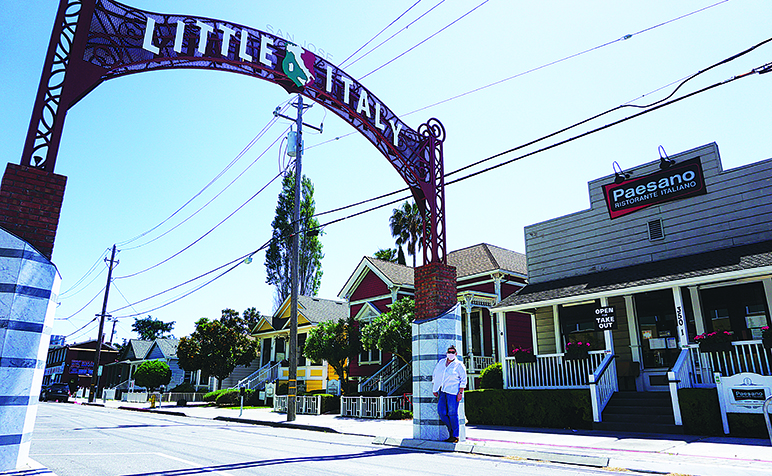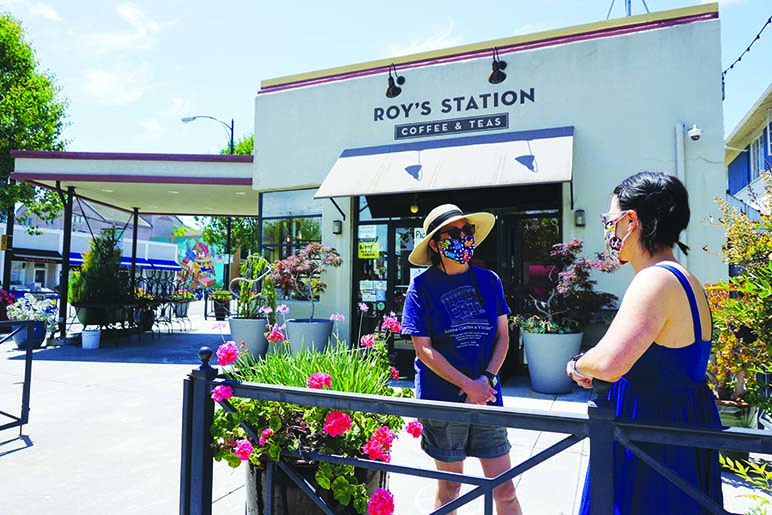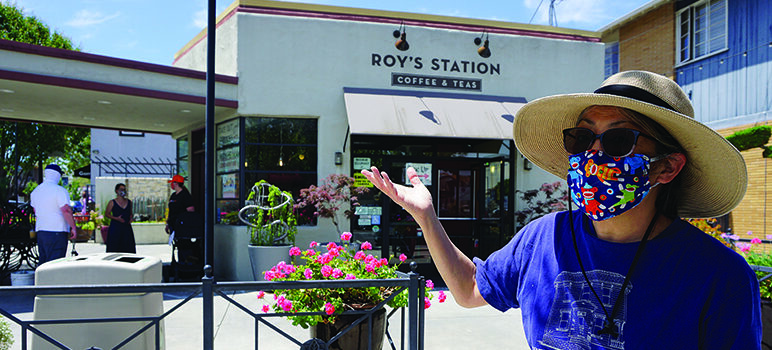Like her forebears who arrived in the Santa Clara Valley generations earlier, Theresa Sabatino came looking for a fresh start.
The clinical psychologist and San Jose native ran an Italian language school in Las Vegas until the 2009 recession slashed attendance by 90 percent. After hearing about plans to turn a decaying pocket of downtown between Highway 87 and the Guadalupe River into an Italian district, Sabatino decided to come home.
“I had to reinvent myself,” she says, “and the fact that this was getting off the ground at the same time gave me a chance to do that.”
When Sabatino’s La Piccola Scuola Nel Parco moved into the sunny yellow Victorian on the edge of the river parkway, nothing about the place hinted at its past as a working-class Italian neighborhood dating back to the 1870s. Henry’s World Famous Hi-Life had long stood in the barn-red building that began life as the Torino Hotel, where migrant Italian laborers stayed through the turn of the 20th Century. An adjacent cluster of quaint, colorful cottages, some of them rescued and moved from other development zones, housed a day spa, but little else.
Fearing the city’s next boom might bury that history, Joshua Devincenzi Melander—a fourth-generation Italian American—began raising money to turn the neglected strip from Julian to West St. John into Little Italy proper. “Italian American contributions are so great to Santa Clara County,” says Melander, whose grandfather founded San Jose’s Italian American Association “But when I saw a lot of the older generation dying, I worried we’d lose some of that history. It seemed like that story was being forgotten.”
In the decade to follow, Melander’s nonprofit raked in enough cash through legacy bricks and philanthropic largesse to erect a three-story Little Italy arch, banners paying homage to 32 prominent Italian Americans and a museum, which has yet to open. In 2011, Paesano Ristorante Italiano settled into one of nine Victorians renovated years earlier by Barry Swenson Builder. In 2015, Bel Bacio moved in on the same block. Fall festas began attracting crowds of 20,000 and fundraising hauls of $30,000 starting in 2016 and Enoteca La Storia joined the cultural revival just two years later.
Then came the pandemic. And with it, the sweeping public health orders that brought life as we know it to a screeching halt.
Paesano and Enoteca have relegated menus to just takeaway orders. Bel Bacio hasn’t served a patron in two months. For the second time in a decade, Sabatino’s enrollment at the bilingual preschool and kindergarten program dropped to just six kids—except this time, none can even attend in person.
As Little Italy’s core tenants grappled with how to survive in a bleak new reality, the landlords continued with business as usual. On May 1, despite imploring property management for help, the rent came due—along with a 3 percent annual increase.
Sabatino says she’ll pay what she can and try to scrape up the rest. But without some kind of break, Little Italy could end up as empty as when she got there, reduced to an arch, some banners and plaques and empty buildings.
“It took years to turn this place into what it is,” Sabatino laments. “I don’t want it to just go away. Then what? It sits here empty for two years? For three? For five?”

Theresa Sabatino surveys a deserted Little Italy. (Photo by Jennifer Wadsworth)
Diverse Districts
Silicon Valley’s myriad cultural enclaves formed from the adversity of discrimination and hope of the American dream. Little Saigon, Little Italy, Little Portugal and Japantown persisted through generations of hardship and withering recessions to become tourist draws and economic engines of the South Bay’s capstone city, anchored by owner-operated independent businesses.
All of that stopped when the entire Bay Area banned everything but essential services to slow the transmission of COVID-19. Fallout from protracted closures and jarring business falloff makes the eateries, nail salons and corner stores that form the backbone of the local economy especially prone to collapse, while big box stores with grocery or pharmacy departments enjoy exemptions for their entire range of merchandise.
Despite the critical job-creating role that the tiniest employers play, there’s no relief optimized for their specific needs from the U.S. Small Business Administration (SBA) or any other government agency. Though most enterprises in San Jose’s cultural centers are family-run with no more than a handful of workers, they’re left to compete for disaster loans against corporations of 500 or more employees. Corporations that, astoundingly, fit within the SBA’s definition of a “small business” and have the banking relationships and in-house financial expertise to navigate the Paycheck Protection Program’s labyrinthine documentation requirements.
In a recent article, the Aspen Institute cautions that the vast majority of federal aid will never reach the small businesses that need it most because the loans aren’t profitable enough for banks to prioritize. The report argues that without targeted investment in micro-lenders—such as San Jose’s Opportunity Fund, which began accepting applications from prospective borrowers this week—thousands of small businesses won't survive the public health measures keeping doors closed and customers at home.
As Congress urges Quantum—a San Jose data-storage company valued at $170 million—to return a $10 million pandemic-relief loan, the Alum Rock Santa Clara Business Association’s 135 members have yet to see a dime from the SBA. In the absence of robust public help, San Jose has appealed to private donors with its Silicon Valley Strong initiative, in which the Opportunity Fund will divvy up $1.5 million in $10,000 chunks to businesses with no more than five employees. That means only 150 of the city’s 80,000-plus businesses will get some shred of relief.
Meanwhile, bans on large gatherings rob cultural districts of the ability to fundraise or draw customers through events such as the Obon Festival in Japantown and Lunar New Year in Little Saigon. The San Jose Downtown Association (SJDA), which represents Little Italy as well as the city’s artsy SoFA District, has to suspend its revenue-generating winter attractions and summer concerts for the foreseeable future.
“We had workforce reductions in the middle of March,” SJDA Director Scott Knies says. “There’s no Music in the Park, no ice rink, no big projects anymore—so no project manager. We had to lay off a couple really good people. It’s been a challenge.”
With fewer resources and unprecedented need, Knies says he’s working around the clock to support the 1,600-plus businesses whose taxes fund the association. The county’s health order left just 8 percent fully operational and 9 percent with reduced service. The remaining 83 percent are closed—some for good.
“You walk down the street and you see the plywood on the windows and you already know,” Knies says. “For the ones that were struggling pre-pandemic, this just pushed them over the edge. And while some are working out customized leases with reduced payments or forgiveness, not everyone is getting relief from their landlords, who have their own expenses to deal with. It’s complicated.”
Absent government-led commercial rent relief for landlords and tenants, it’s up to private parties to hammer out deals on a case-by-case basis. Since SJDA represents owners and lessees alike, Knies says he’s doing what he can to make those conversations happen.
The main priority for now, he says, is to work with the city on opening streets and sidewalks for al fresco dining. “If we’re going to liberalize some of these public spaces and figure out a restriction on the number of tables and social distancing and all that, we can have restaurants serve people on Fountain Alley, Grove Alley and Post Street,” Knies says. “Our cultural districts—SoFA, Little Italy—are natural places for this with their plazas, paseos, parklets and parking lanes.”
Not only would the idea give San Jose a chance to market its 300-days-a-year of sunshine, it would allow restaurants walloped by a 70 percent drop in business to hire back furloughed workers. By closing some streets, the city could get more money to change hands, give people a safe place to socialize and make downtown feel alive again.
Hopefully, Knies says, a simple stopgap like banning cars could make the alley from Enoteca to Paesano’s a lifeline for Little Italy.
Still, it won’t be enough to save everyone, Knies warns: “We’re going to have vacancies everywhere as we come out of this.”
Turning Japanese
The normally crowded patio at Roy’s Station Coffee and Teas sits empty except for a few masked patrons chatting up one of the owners, Jasmine Rast, 39. Hand-drawn poster board signs announce the Japantown café’s new takeout service and limited hours of operation. The cash register stands right at the entrance, a plastic shield dividing customers from the employees inside.
Carole Rast—the 60-year-old matriarch of the family that owns the gas station-turned-coffeehouse—says Mother’s Day used to bring a rush of customers.
“It feels strange that it’s so quiet,” she says, taking a break from trimming the potted plants outside the shop. “Normally, you’d have people, families, coming here to buy a latte after that pancake breakfast,” she says, motioning down Sixth Street, where the event historically takes place at a Buddhist temple. “Normally, you have seniors going out for their walks, stopping to say hi.”
Now, they’re more isolated than almost anyone, Carole says. With a high concentration of elderly residents at Fuji Towers senior apartments, the neighborhood just north of downtown is particularly vulnerable to COVID-19, which is deadlier for people over 50. But the older generation has seen Japantown endure far worse than the pandemic, she says, and that gives her some measured optimism about the district’s future.
Founded in the 1880s as a Chinese settlement bounded by Sixth, Seventh, Taylor and Jackson streets, the neighborhood expanded over the ensuing decades to include Filipino and Japanese immigrants. Japantown spawned shops, restaurants, a boarding house, a baseball team. It became a thriving town within a town—until Franklin Delano Roosevelt’s Executive Order 9066 sucked the life out of it.
Only three U.S. Japantowns survived World War II, when the government rounded up people of Japanese descent and kept them in remote concentration camps until the fighting ended. And only one—San Jose’s—remains in its original spot, thanks to a lawyer named Ben Peckham who protected Japanese property by transferring it into his name until families returned to reclaim it.
“So, yeah, we’ve been through worse,” Carole reflects, staring at a plaque-adorned bench memorializing Peckham’s good deed.
Tamiko Rast, her 40-year-old daughter and president of the Japantown Business Association, says her nonprofit can provide only nominal support—like keeping members up to date on the latest pandemic news and steering them to various agencies should they need any help. Thankfully, Tamiko says, many of Japantown’s multi-generational businesses enjoy low property taxes and below-market rents. There’s been only one closure so far, Banana Crêpe, but the dessert spot was planning to close anyway.
“I think we’re going to be OK,” Tamiko says. “I mean, it’s not going to be easy. Everyone’s suffering. The businesses that are opening are barely making it, or just covering expenses, or just, like, plugging the holes in the dike.”
Of course, the crisis will hit some ethnic enclaves harder than others.
Like, for example, Little Saigon, which runs along Senter, Tully and Story roads, and emerged as an expression of a lost homeland for waves of Vietnamese refugees who began arriving in the mid 1970s—a century after the Chinese and Japanese began forming their own communities in the South Bay. Though Little Portugal dates back to the 19th Century, the area includes some of San Jose’s neediest residents and a business district that already faced pre-pandemic existential challenges.
Yet there’s reason to stay hopeful about even the most impoverished neighborhoods. Though newer immigrants deal with greater economic precariousness, now and before the crisis, they also tend to be more entrepreneurial than native-born Americans.
According to the Kauffman Index, a leading indicator of new business creation in the U.S., foreign-born residents are twice as likely to start a company. Meanwhile, data from the New American Economy Research Fund found that refugees and immigrants without college degrees are even more likely to become job creators.
That’s what brought Jesus Flores to the states, and eventually to San Jose. “The minute I came to the U.S., as I was looking around, all I would see was opportunity,” he says. “And that is the truth to many immigrants.”

Carole Rast chats with her daughter Jasmine Rast outside their family-owned cafe. (Photo by Jennifer Wadsworth)
East Side Story
When Jesus Flores moved his income tax, real estate and notary firm to Little Portugal in 2011, the place was still reeling from the subprime mortgage crash, which emptied homes and hollowed out storefronts in the East San Jose enclave. But the district’s long history of immigrant entrepreneurship gave the Mexico City transplant faith in its eventual recovery. And the neighborhood’s proximity to the Mayfair barrio brought him closer to the core clientele of his eponymous Flores Professional Services.
“I wanted to be part of a community that needs our help,” says Flores, a 52-year-old father of six who immigrated to the U.S. when he was 17.
The hardships that followed required more of his help than he ever expected.
Construction on Santa Clara Valley Transportation Authority (VTA) rapid bus line tore up Alum Rock Boulevard as it fell years behind and vastly over budget. Shops, restaurants and offices saw a precipitous drop in patronage because the tractors and maze of orange traffic cones made the thoroughfare so tough to navigate for four years—twice as long as the transit agency said it would take to finish the project.
Little Portugal banded together, forming the Alum Rock Santa Clara Business Association to lobby the VTA for some relief. Flores became president of the fledgling chamber in 2015 and spent his free time helping businesses sign up for VTA’s monetary amends, which went up to $50,000 as long as applicants could prove their losses.
“Unfortunately, a lot of them didn’t have their finances organized,” Flores says, “and they weren’t able to show how much they lost.”
So, he began offering free workshops for small business owners, teaching the mostly Latino and immigrant entrepreneurs about things like bookkeeping, taxes and corporate structure. Despite those efforts, Flores says the VTA boondoggle ultimately wiped out as many as 50 local businesses.
The Silicon Valley BART extension and Google’s grand plans for downtown brought a new threat to Little Portugal, which UC Berkeley’s Urban Displacement Project identified as one of three San Jose neighborhoods at greatest risk of gentrification. In the span of a month last summer, without prior warning, a proposed 84-unit housing project displaced four longstanding businesses at East Santa Clara and 24th streets: El Aguila Restaurant, El Divo Beauty Salon, California Car and Audio and Botanica y Novedades San Pablo.

Jesus Flores (bottom right) founded Latino Business Council Silicon Valley to help the kinds of family-owned enterprises hit hardest by the pandemic.
In no small part because Flores pushed the issue, the city launched an anti-displacement pilot initiative in Little Portugal earlier this year. He never imagined that a greater crisis loomed just around the corner, threatening to undo years of work trying to protect Mayfair and Little Portugal from the disruption of San Jose’s inexorable growth.
When the coronavirus pandemic prompted the county on March 16 to issue a stay-at-home order, San Jose’s pilot commercial anti-displacement initiative got rolled into the city’s broader effort to help businesses survive the economy skidding to a stop.
“That gave us a head start,” says Kerry Adams Hapner, San Jose’s deputy director of economic development and head of the city’s Office of Cultural Affairs. “We want to do all we can for the businesses in these neighborhoods, which are a very important part of not only our identity but our economy. They represent who we are as San Jose, one of the most diverse cities in the United States. That’s really a sense of pride for us.”
Indeed, of San Jose’s 50,000 small businesses, which account for 155,000 jobs, 60 percent are minority-owned, according to the city’s Office of Economic Development.
Councilwoman Magdalena Carrasco, whose District 5 spans the Alum Rock corridor, lauds Flores as “a one-man show” and model of immigrant ingenuity and hustle.
The local lawmaker says she believes that the Latino Business Council Silicon Valley—a nonprofit spinoff Flores founded to expand his workshops to the whole county—could chart a path out of this crisis for mom-and-pop owners and immigrant entrepreneurs who create tens of thousands of jobs in the region.
Some populations will need more aid than others, Carrasco notes. Taquerias and pho joints in Little Saigon and East Side often take cash only and may lack credit card scanners. And without a stellar credit history or meticulous bookkeeping, they’re less likely to qualify for the federal loans that comprise the bulk of the government’s relief efforts. Flores has made it his mission to help exactly those kinds of family-run ventures, which he says make up the fabric of San Jose.
“We need to figure out how to keep these micro-businesses afloat,” Carrasco says. “ We can’t let them drown, and we can’t let them go away.”


Excellent story, Jennifer. You did a terrific job of humanizing the statistics — I’m sure people were aware that small businesses are failing due to the pandemic, but it helped (me, at least) to read and understand how many ways the pandemic can crush a business.
I’ve got an idea…. Open Up the Damn Economy!
I want to go out and support these people so why can’t I? If you don’t want to go out to eat, STAY HOME.
We were asked to Shelter in Place to flatten the curve so we wouldn’t overwhelm the medical system. Now nurses are being furloughed and hospitals are on the verge of bankruptcy due to lack of patients, Mission Accomplished. Let’s get back to work.
Makes perfect sense.
Those who are fearful can self-quarantine.
Agreed Work90. Looks like Santa Clara Cty has taken an even harder line than San Mateo Cty and San Francisco, which at least are now following Newsom’s Stage 2 reopening plan. Starting to feel a little arbitrary. Is it that different here from just 20 miles north?
Oh wow. Ethnically diverse people are being impacted.
This really IS serious.
The hijacking by large corporations of the SBA program for small businesses and other bail out programs, who never should have been given SBA loans, is a national disgrace. A decade ago the “too big to fail” crowd led by Morgan Stanley were bailed out, not by the government, but by the bought and paid for politicians on both sides of the aisle who gave away the taxpayers’ money to keep them afloat. Remember, the government at every level gives nothing. They just redistribute taxpayer money; our money, not theirs. The motto now seems to be “too small to allow to succeed”. And both the politicians and their large corporation and CEO benefactors are shameless about this travesty they have perpetrated.
The first COVID bailout bill was 800 pages or so with lots of pork for special interests. The second one being proposed by the House is 1,800 pages or so. I wonder if Pelosi will argue as she did with the Obamacare bill it has to be passed so we will know what’s in it. One sure thing, there will be lots more pork.
Dr. Cody’ s incredibly excessive and undoubtedly unconstitutionally overbroad order closed 83% of SJDTA’s 1600+ businesses. How many more businesses throughout the entire county have also been forced to close? That’s government for you—using a chain saw instead of a scalpel. Little of the claimed benefit would withstand the scrutiny of unbiased peer review Cody and other government health officials nationwide, and politicians at all levels of government, remain entranced by the new Rasputin, Dr. Fauci; despite the fact that very little of what he has predicted has actually come to pass. Cody’s order and that of Governors and Health Department officials nationwide are unprecedented—quarantine the 99% who are healthy instead of the few who are sick. The result is 30 million plus unemployed within two months.
That said, a little more scrutiny of Jennifer’s excellent story is in order. People like Jesus Flores are what has made America great. Jesus came here, worked hard, became an American, not a hyphenated American. He’s a real gem.
I was immediately struck by Mr. Flores’ statement that the businesses he served didn’t have their finances organized, so they could not prove their claimed losses due to the VTA Alum Rock Corridor construction debacle. (Does VTA ever get anything right?) That sounded like code to me, that those business took in a lot of cash which they didn’t report on their taxes, which is why they couldn’t prove their claimed losses. My suspicion was confirmed in the penultimate paragraph of Jenn’s story when she described the current plight of the East Side taquerias and pho joints that accept only cash. How many undocumented workers do you think they employ? Surely neither many of those businesses nor their many illegal employees pay their fair share of taxes.
Stay tuned as the US oligarchs continue to turn us into Soviet Union 3.0, with barely a peep from the US sheep.